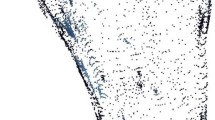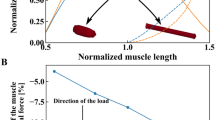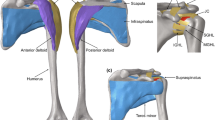Abstract
The majority of musculoskeletal injuries located in the shoulder are often due to repetitive or sustained movements that occur in work routines in different areas. In the case of musicians, such as violinists, who have long and daily training routines, the repetitive movements they perform are forced and sometimes the postures are not natural. Therefore, this article aims to study and simulate the dynamic behavior of the glenohumeral joint under repetitive conditions that represent the different postures assumed by a violinist during his daily training. For this purpose, the criteria provided by the RULA (rapid upper limb assessment) method have been used. Subsequently, by using as a reference geometry that of the articulation under study generated and modeled in CATIA®[VERSIÓN 5R21], a FEM analysis has been proposed with the software ANSYS®[VERSIÓN 17.1] simulating the short and cyclic movements of the Humerus of the violinists. With the analysis carried out, thanks to linear and isotropic approximations of the joint, it has been possible to know the approximate dynamic behavior of tissues, muscles and tendons, and the response of the joint in terms of fatigue.














Similar content being viewed by others
References
Brunelli, M.P., and Gill, T.J., Fractures and tendon injuries of the athletic shoulder. Orthop. Clin. North Am. 33(3):497–508, 2002.
Calle, Y., and Hincapie, S., CES Movimiento y Salud., vol. 2, no. 1. 2014.
Allman, F.L., Fractures and ligamentous injuries of the clavicle and its articulation. J. Bone Joint Surg. Am. 49(4):774–784, 1967.
McKoy, B.E., Bensen, C.V., and Hartsock, L.A., Fractures about the shoulder: conservative management. Orthop. Clin. North Am. 31(2):205–216, 2000.
Eiff, M. P., Hatch, R., and Higgins, M. K., Fracture management for primary care. Saunders/Elsevier, 2012.
Ellenbecker, T. S., Clinical examination of the shoulder. W.B. Saunders, 2004.
Moore, K. L., Agur, A. M. R., Dalley, A. F., and K. L. D. of (work) Moore, Essential clinical anatomy.
Quillen, D.M., Wuchner, M., and Hatch, R.L., Acute shoulder injuries. Am. Fam. Physician. 70(10):1947–1954, 2004.
Zaza, C., and Farewell, V.T., Musicians’ playing-related musculoskeletal disorders: An examination of risk factors. Am. J. Ind. Med. 32(3):292–300, 1997.
de Moraes, G.F., and Antunes, A.P., Musculoskeletal disorders in professional violinists and violists. Systematic review. Acta Ortop. Bras. 20(1):43–47, 2012.
Lederman, R.J., Neuromuscular and musculoskeletal problems in instrumental musicians. Muscle Nerve. 27(5):549–561, 2003.
Schuele, S.U., and Lederman, R.J., Occupational disorders in instrumental musicians. Med. Probl. Perform. Art. 19(3):123–129, 2004.
Heming, M.J.E., Occupational injuries suffered by classical musicians through overuse. Clin. Chiropr. 7(2):55–66, 2004.
Nyman, T., Wiktorin, C., Mulder, M., and Johansson, Y.L., Work postures and neck–shoulder pain among orchestra musicians. Am. J. Ind. Med. 50(5):370–376, 2007.
Marqués, F., Directrices para la Decisión Clínica en Enfermedades Profesionales. Instituto nacional de seguridad e higiene en el trabajo, Madrid. Instituto nacional de seguridad e higiene en el trabajo, Madrid. 2010.
Rietveld, A.B.M., Dancers’ and musicians’ injuries. Clin. Rheumatol. 32(4):425–434, 2013.
Wojciechowski, S., Maruda, R.W., Barrans, S., Nieslony, P., and Krolczyk, G.M., Optimisation of machining parameters during ball end milling of hardened steel with various surface inclinations. Measurement. 111:18–28, 2017.
Jarosz, K., Löschner, P., Niesłony, P., and Krolczyk, G., Optimization of CNC face milling process of Al-6061-T6 aluminum alloy. J. Mach. Eng. 17(1):69–77, 2017.
Ruggiero, A., Merola, M., and Affatato, S., On the biotribology of total knee replacement: A new roughness measurements protocol on in vivo condyles considering the dynamic loading from musculoskeletal multibody model. Measurement. 112:22–28, 2017.
Ruggiero, A., Affatato, S., Merola, M., and De, M. C., FEM analysis of metal on UHMWPE total hip prosthesis during normal walking cycle. In Proceedings of the XXIII conference of the Italian Association of Theoretical and Applied Mechanics (AIMETA 2017), pp. 4–7, 2017.
Merola, M., Ruggiero, A., De Mattia, J.S., and Affatato, S., On the tribological behavior of retrieved hip femoral heads affected by metallic debris. A comparative investigation by stylus and optical profilometer for a new roughness measurement protocol. Measurement. 90:365–371, 2016.
Ruggiero, A., D’Amato, R., and Gómez, E., Experimental analysis of tribological behavior of UHMWPE against AISI420C and against TiAl6V4 alloy under dry and lubricated conditions. Tribol. Int. 92:154–161, 2015.
Ruggiero, A., Amato, R.D.’., Gómez, E., and Merola, M., Experimental comparison on tribological pairs UHMWPE/TIAL6V4 alloy, UHMWPE/AISI316L austenitic stainless and UHMWPE/AL2O3 ceramic, under dry and lubricated conditions. Tribol. Int. 96:349–360, 2016.
Ruggiero, A., Gòmez, E., and D’Amato, R., Approximate analytical model for the squeeze-film lubrication of the human ankle joint with synovial fluid filtrated by articular cartilage. Tribol. Lett. 41(2):337–343, 2011.
D’Amato, R., Calvo, R., and Gómez, E., Sensitivity study of the morphometric fitting on the pressure field inside ankle joints. Case Stud. Mech. Syst. Signal Process. 1:8–14, 2015.
Ruggiero, A., Gómez, E., and D’Amato, R., Approximate closed-form solution of the synovial fluid film force in the human ankle joint with non-Newtonian lubricant. Tribology International. 57:156–161, 2013.
Diego-Mas, J.-A., Poveda-Bautista, R., and Garzon-Leal, D.-C., Influences on the use of observational methods by practitioners when identifying risk factors in physical work. Ergonomics. 58(10):1660–1670, 2015.
David G. C., “Ergonomic methods for assessing exposure to risk factors for work-related musculoskeletal disorders.”
LI, G., and BUCKLE, P., Current techniques for assessing physical exposure to work-related musculoskeletal risks, with emphasis on posture-based methods. Ergonomics. 42(5):674–695, 1999.
Mcatamney, L., and Corlett E. N., RULA: a survey method for the. irwestigation of world-related upper limb disorders. Appl. Ergon. 19%. U(2):91–99.
Milner, G.R., and Boldsen, J.L., Humeral and femoral head diameters in recent white American skeletons. J. Forensic Sci. 57(1):35–40, 2012.
Rockwood, C.A., Matsen, Wirth, and Lippit. Hombro, Márban, 2013.
CES Edu Pack. Granta Design, Cambridge, 2017.
Holzapfel, G., Biomechanics of soft tissue. Handb. Mater. Behav. 3(1):1049–1063, 2000.
Schechtman, H., and Bader, D. L., In vitro fatigue of human tendons. J. Biomech. 30(8):829–835, 1997.
Chen, E. J., Novakofski, J., Jenkins, W. K., and O’Brien, W. D., Young’s modulus measurements of soft tissues with application to elasticity imaging. IEEE Trans. Ultrason. Ferroelectr. Freq. Control. 43(1):191–194, 1996.
Kent-Braun, J. A., Fitts, R. H., and Christie A., “Skeletal muscle fatigue,” In: Comprehensive Physiology, vol. 2, no. 2, Hoboken, NJ: John Wiley & Sons, Inc., pp. 997–1044, 2012
I. A. Ibrahim A. Kapandji, E. Martínez, and A. Jornet Cases, Cuadernos de fisiología articular: esquemas comentados de mecánica articular. Barcelona: Toray-Masson, 1982.
Cheng, P. L., Simulation of Codman’s paradox reveals a general law of motion. J. Biomech. 39(7):1201–1207, 2006.
Pearl, M. L., Sidles, J. A., Lippitt, S. B., Harryman, D. T., and Matsen, F. A., Codman’s paradox: Sixty years later. J. Shoulder Elb. Surg. 1(4):219–225, 1992.
Author information
Authors and Affiliations
Corresponding author
Ethics declarations
Conflict of Interest
Manuel Islan declares that she has no conflict of interest. Fernando Blaya declares that he has no conflict of interest. Pilar San Pedro declares that he has no conflict of interest. Roberto D’Amato declares that he has no conflict of interest. Emilio Lechosa Urquijo declares that he has no conflict of interest. Juan Antonio Juanes declares that he has no conflict of interest.
Ethical Approval
This article does not contain any studies with human participants or animals performed by any of the authors.
Additional information
This article is part of the Topical Collection on Education & Training
Rights and permissions
About this article
Cite this article
Islan, M., Blaya, F., Pedro, P.S. et al. Analysis and Fem Simulation Methodology of Dynamic Behavior of Human Rotator Cuff in Repetitive Routines: Musician Case Study. J Med Syst 42, 55 (2018). https://doi.org/10.1007/s10916-018-0908-7
Received:
Accepted:
Published:
DOI: https://doi.org/10.1007/s10916-018-0908-7




